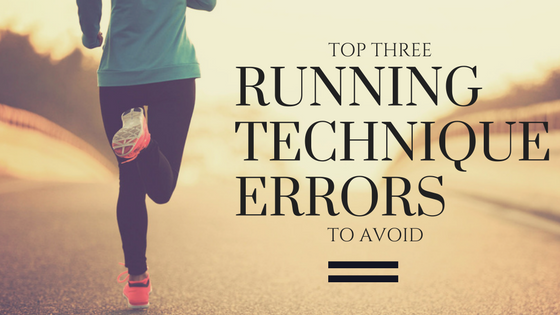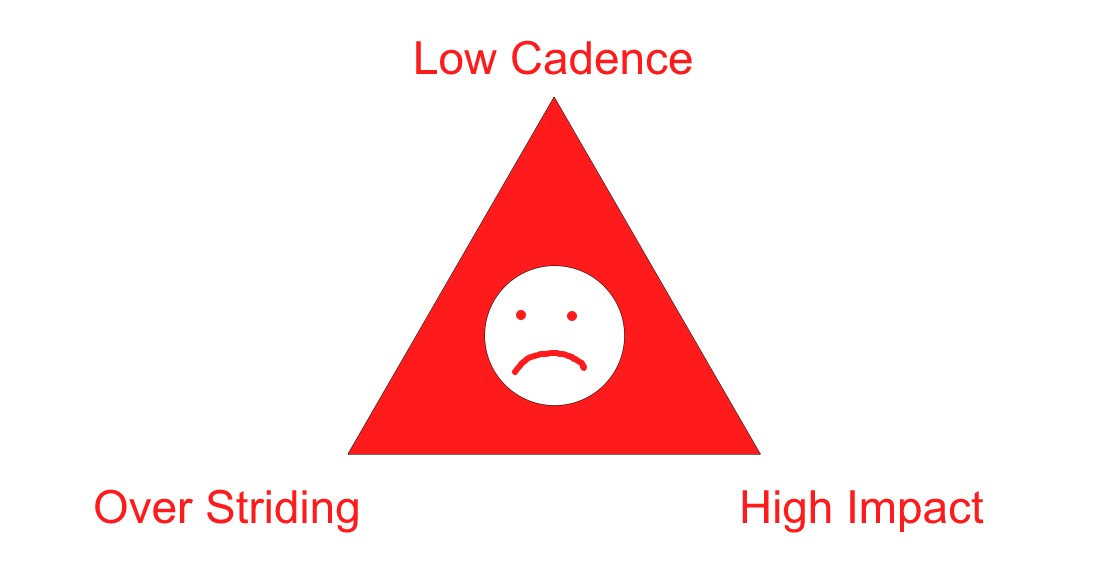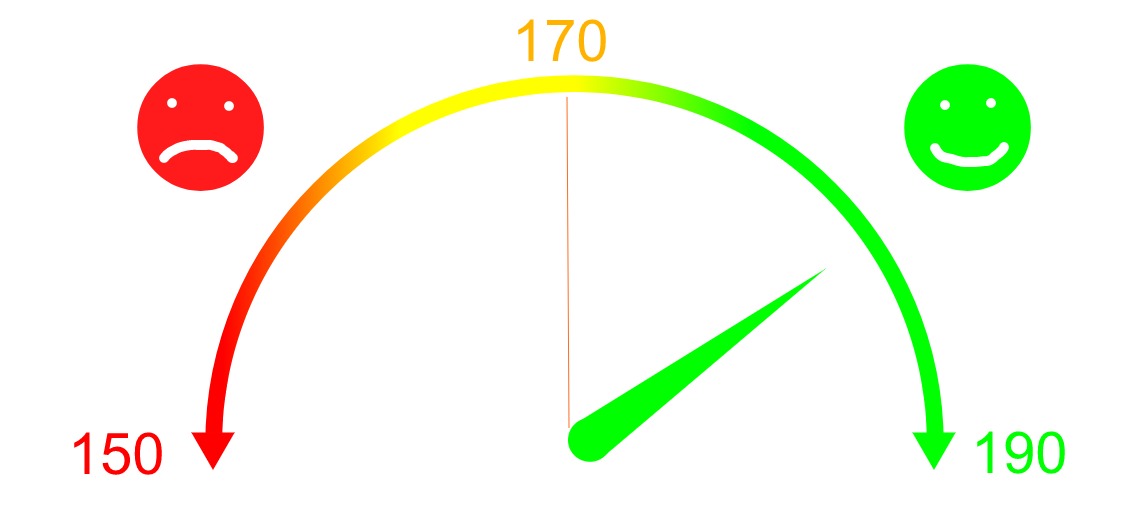
Working with recreational runners on a day-to-day basis, I’ve noticed that some running technique errors are far more common than others. In fact, I’ve noticed three running technique errors that are super common. Interestingly, these three errors are linked to each other. If you do one you’re more like to do the other two.
This is actually an advantage for those of us looking to improve our running form. If we can improve one of these three errors we are likely to improve the other two. In this article, we are going to unpack the top three running technique mistakes and how to avoid them.
What are The Top Three Running Technique Errors?
I call the top three running technique errors the “Unhappy Triad of Running Technique”. They are low running cadence, high impact forces and overstriding. I’ve put the unhappy triad into a beautiful graphic designed by yours truly.

Let’s start with Cadence
Running Cadence is the number of steps you take each minute. You can work your own cadence out pretty easily by counting the number of times your left foot hits the ground in 10 seconds. Then multiply that number by 12 to get your cadence in steps per minute. For example, if you count 15 steps with your left foot in 10 seconds your cadence would be:
Cadence = 15 x 12 = 180 spm (steps per minute)
You can also download a metronome app and adjust the beats per minute until it matches your steps as you run. This tells you your steps per minute (cadence).
I define a low cadence as anything below 170. Most recreational runners that I work with have a low running cadence and it’s commonly in the 150-170 range. I call this the “Unhappy Zone of Running Cadence”. Most professional or high-performing runners adopt a cadence somewhere in the 170-190 range and I call this the “Happy Zone of Running Cadence”. Prepare yourself for another magnificent graphic.

So why is the lower cadence zone the unhappy zone? Well, that’s because if you run with a lower cadence you are more likely to demonstrate the other two of the top three running technique mistakes. As I said, these three are all linked.
When you run at a given speed with a lower cadence you take fewer steps in that minute. To maintain the same speed those steps will have to be bigger. I’ve discussed the relationship between stride length and cadence in more depth previously. Taking bigger steps is likely to make you reach your foot out quite far in front of you before you land. This is known as Overstriding.
Overstriding
Overstriding is landing with your foot too far out in front of you as you run. Specifically, your initial contact with the ground is too far out in front of your centre of mass. This means that you are creating a braking force that you will need to overcome in order to continue to propel yourself forwards.
I have written previously about the negative effects of overstriding so check out that article if you want to go into a bit more depth. Essentially though, over striding is running with the brakes on. Imagine driving your car with your parking brake on. You may still be able to drive the car but you will have to work the engine way harder to produce the same speed. That’s exactly what runners who are over striding have to do. They can still run but they need to work harder to maintain the same speed.
Another negative aspect of overstriding is the fact that you tend to hit the ground harder. I call this high-impact forces.
High Impact Forces
When you are overstriding you tend to keep your knee quite straight and hit the heel hard as you land. This means that you can’t effectively cushion the impact and you will make more noise as you land.

For a quick example just stand up and jump up and down. Now try and land as quietly as you can. Now try and land on your heels with your knees straight (don’t jump very high). Pretty noisy, right? That’s those high-impact forces.
High impact forces have been correlated with increased injury incidence. I talk a lot more about this in my article Am I a Heavy Runner? So check that out if you want to learn more.
How it all fits together
Running with a low cadence of 150-170 steps per minute is likely to lead to overstriding. Overstriding is bad for your performance as it effectively means you are running with the brakes on. Overstriding also tends to make you land harder with higher impact forces. This might increase your injury risk (for certain injuries).
What should I do about it?
There is no magic formula here. The goal is to avoid all three aspects of the Unhappy Triad of Running Technique. So we want to avoid low cadence, overstriding and high impact forces. So here is our checklist:
- Cadence 170 – 190
- Land with your foot close to underneath your centre of mass
- Land quietly
There are specific cues for each aspect. I usually recommend runners start by determining their current running cadence. You can do this by counting the number of steps you take with your left foot in ten seconds and multiplying that number by twelve. Alternatively, you can download a metronome for your smartphone (I use Pro Metronome) and just try and match the metronome beats to your footsteps as you run.
If your cadence is between 170 and 190, that’s great. Your cadence is in the happy zone and you don’t need to work on it. I would recommend that you check out my articles on overstriding and high impact forces just to check you are also avoiding those errors.
If your cadence is between 150 and 170, don’t stress, this is extremely common. Your cadence is in the unhappy zone and it may be beneficial to increase it a little. If you decide to try it you will want to calculate your current running cadence. Check your GPS watch if you use one as you may see that it tracks your cadence. If not, use a metronome or the calculation method mentioned above.
Once you know your cadence you want to add 10% to it. This is actually pretty easy to do in your head. 10% will be the same a the first 2 digits. So if your cadence is 160, then 10% is 16. Just add the 16 to 160 to get 176. Now set your metronome to 176 and see if you can match the beats with your footsteps. If you do that but it feels crazy-hard, drop down to a 5% increase. If that feels more manageable, start with that.
If you can do that without too much trouble then try and run with the higher cadence for 1 minute of every 5 minutes on your runs. Once you feel like you are doing well with that increase to 2 minutes of every 5. And so on and so forth.
Your goal is to get to that 170-190 range. However, I often see runners with a cadence in the 140s. Trying to bump that up to 170 would be dumb. Running would become exhausting, inefficient and unpleasant. The increase wants to be mildly uncomfortable, that’s all. Any more than that is too much. If your cadence is very low (<150), start with a 5-10% increase. Get your body used to that over a 3-6 month period. Then increase another 5-10% until you get into the “happy zone” (170-190).